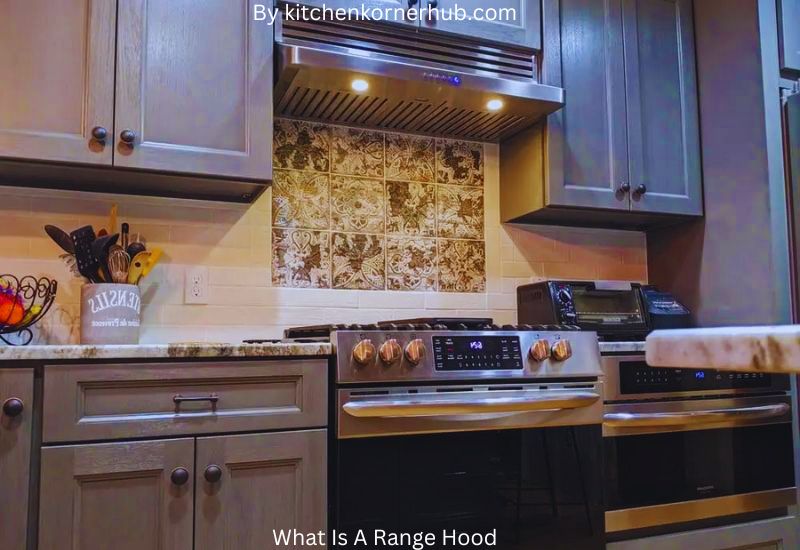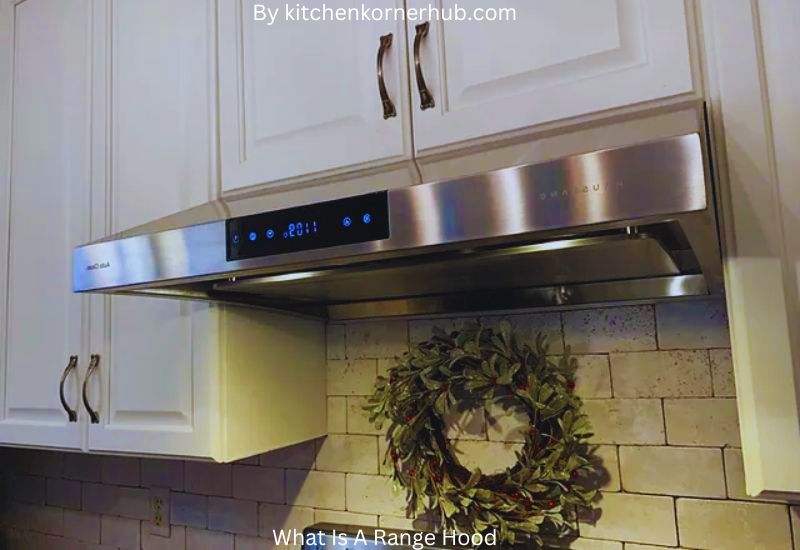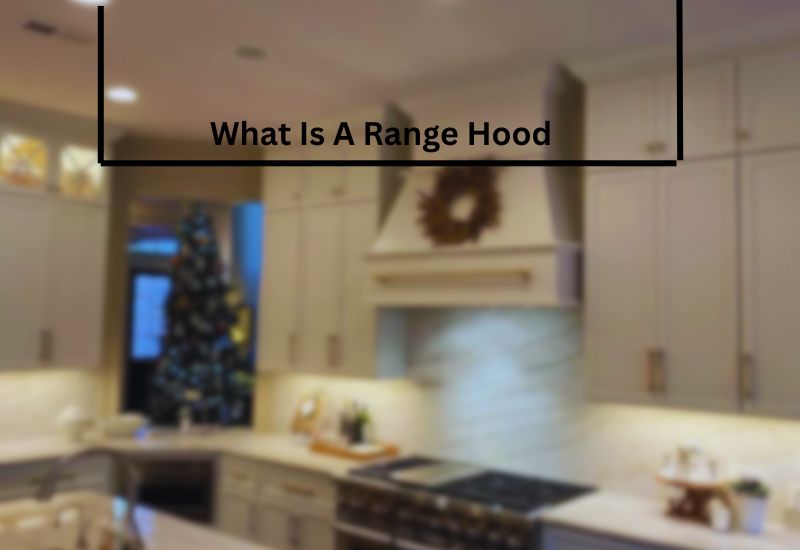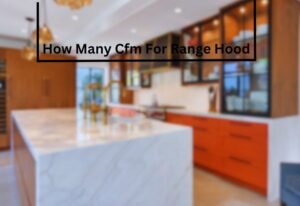A range hood is a vital kitchen appliance designed to improve air quality and add a touch of elegance to your cooking space. This ingenious device, commonly suspended above your stovetop, serves the important function of capturing and venting out smoke, odors, steam, and airborne grease that result from cooking. But it’s not just about function – range hoods also come in a variety of styles, making them an aesthetic addition to your kitchen decor.
What Is A Range Hood? A range hood is a kitchen appliance designed to extract smoke, odors, grease, and airborne particles generated during cooking. It is typically installed above a cooktop or range to improve indoor air quality by venting these pollutants outside, enhancing ventilation and maintaining a cleaner kitchen environment.
Imagine the sizzle of your favorite stir-fry or the aroma of a hearty breakfast filling the air, but without the worry of lingering odors or smoke clouds. That’s where a range hood comes into play. By effectively removing airborne particles, it ensures a fresher and more comfortable kitchen environment. So whether you’re a culinary enthusiast or simply seeking cleaner air while cooking, understanding the features and benefits of range hoods can greatly enhance your cooking experience and the overall atmosphere of your home.
Understanding Range Hoods: An Essential Kitchen Appliance

In the bustling domain of the modern kitchen, range hoods stand as indispensable sentinels, working diligently to keep the culinary haven clean, smoke-free, and odorless. From their inception as functional necessities, range hoods have evolved into sophisticated appliances that not only cater to ventilation needs but also enhance the overall aesthetics of the kitchen. This comprehensive exploration unveils the multifaceted significance of range hoods, shedding light on their mechanics, benefits, and diverse variations.
Ventilation Mechanics: Nurturing Clean Air
At its core, the primary role of a range hood is to ensure optimal air quality within the kitchen. It achieves this through a combination of mechanisms – capturing smoke, fumes, steam, and airborne particles emitted during cooking and whisking them away. A powerful fan system directs the captured air through a series of filters, effectively removing grease, pollutants, and odors before releasing the purified air back into the kitchen. This diligent ventilation process not only keeps the environment comfortable but also safeguards the kitchen from potential damage caused by excess moisture and grease accumulation.
Benefits Beyond Air Quality: A Culinary Ally
Beyond their air-purifying prowess, range hoods contribute to a seamless cooking experience. By effectively removing heat generated during cooking, they help maintain a comfortable ambiance, especially during the preparation of elaborate meals. This cooling effect can result in energy savings, as the kitchen’s cooling systems need not work as hard. Additionally, range hoods prevent the accumulation of grease on kitchen surfaces, reducing the need for frequent cleaning and thereby ensuring a hygienic environment.
Aesthetic Integration: From Functional to Stylish
Range hoods have transcended their utilitarian beginnings to become design elements that can elevate the visual appeal of a kitchen. With a myriad of styles, materials, and finishes available, they seamlessly integrate into various kitchen aesthetics – from traditional to modern, rustic to industrial. Island hoods, wall-mounted hoods, and under-cabinet hoods offer versatile choices to match the kitchen layout. Some models even come equipped with adjustable lighting, further enhancing their decorative impact while illuminating the cooking space.
Choosing the Right Fit: Factors to Consider
Selecting the ideal range hood entails evaluating several factors. The size of the cooking area, type of stove, and cooking habits play a significant role in determining the appropriate hood size and ventilation power. For instance, high-output stoves may require more robust ventilation to effectively manage the increased heat and fumes they generate. Noise levels produced by the fan system should also be considered, particularly for open-concept kitchen layouts where a quieter operation is desired. Proper installation height is crucial for efficient performance, preventing any hindrance to airflow.
Innovations and Future Trends: Smart and Sustainable
As technology advances, range hoods have embraced innovation to cater to modern living demands. Smart range hoods, equipped with sensors and connectivity features, adjust ventilation levels based on real-time cooking conditions. Some models can even sync with smart home systems, enhancing user convenience. Moreover, an increasing focus on sustainability has led to the development of energy-efficient range hoods that consume less power while maintaining optimal performance.
The Purpose and Functionality of Range Hoods

Range hoods, often overlooked in kitchen appliances, play a vital role in maintaining a clean and safe cooking environment. These unassuming fixtures serve more than just an aesthetic purpose, offering a range of functions that contribute to a healthier and more efficient cooking experience. From eliminating odors to improving air quality, range hoods offer various benefits that shouldn’t be underestimated.
Odor Removal and Air Quality Enhancement
One of the primary functions of range hoods is to eliminate cooking odors and improve indoor air quality. As we cook, various odorous particles and fumes are released into the air, which can linger and spread throughout the home. Range hoods are equipped with powerful ventilation systems that capture these particles, carrying them outside through a duct or filtering them before recirculating the air. By doing so, range hoods prevent unpleasant odors from permeating the living space and ensure a fresher atmosphere.
Smoke and Grease Extraction
Cooking processes such as frying and grilling can release substantial amounts of smoke and grease into the air, leading to not only unpleasant smells but also potential health hazards. Range hoods are designed to effectively capture and remove these particles, preventing them from settling on surfaces and reducing the risk of respiratory issues. Grease filters in range hoods trap airborne grease particles, preventing them from accumulating on kitchen surfaces and appliances, thus simplifying the cleaning process.
Moisture Control and Mold Prevention
During cooking, steam and moisture are generated, which, if not properly managed, can contribute to the growth of mold and mildew in the kitchen. Range hoods help control excess moisture by efficiently ventilating the air. By expelling moist air to the outside or filtering it before recirculation, range hoods aid in maintaining an optimal humidity level in the kitchen, minimizing the potential for mold growth and protecting the structural integrity of the space.
Temperature Regulation
Cooking processes often involve high heat, and a range hood can contribute to temperature regulation within the kitchen. It helps dissipate excess heat and prevents the accumulation of heat in the cooking area, creating a more comfortable and safer environment for the chef. This feature can be particularly valuable during summer months when cooking indoors might contribute to elevated temperatures.
Protection of Cabinetry and Appliances
Without proper ventilation, the accumulation of grease, steam, and airborne particles can damage cabinetry, walls, and nearby appliances over time. Grease can discolor surfaces, steam can lead to warping, and airborne particles can settle on and potentially damage delicate appliances. A range hood acts as a barrier, intercepting these particles and preventing them from causing harm to the kitchen infrastructure.
Types of Range Hoods: A Comprehensive Overview

Range hoods have become an essential appliance in modern kitchens, serving the vital function of extracting smoke, odors, and grease from the cooking area. With various designs and capabilities available, it’s important to understand the different types of range hoods to choose the one that best suits your culinary needs and kitchen setup.
Wall-Mounted Range Hoods:
Wall-mounted range hoods are a popular choice and are typically installed against the wall above the cooking range. They come in a range of sizes and designs to fit different kitchen aesthetics. These hoods effectively remove airborne pollutants by drawing them upwards and venting them outside through ductwork. Some models also offer additional features such as adjustable fan speeds, LED lighting, and even touch-sensitive controls.
Under-Cabinet Range Hoods:
Under-cabinet range hoods are installed beneath kitchen cabinets above the cooking range. These hoods are a space-saving solution and provide efficient ventilation. They are suitable for kitchens with limited space or where a wall-mounted hood might obstruct a window or other design elements. Under-cabinet hoods are available in various styles, from sleek and minimalist to more ornate designs that complement the kitchen’s decor.
Island Range Hoods:
For kitchens with cooking ranges placed on islands or free-standing counters, island range hoods are the ideal choice. Suspended from the ceiling, these hoods effectively remove smoke and odors without the support of surrounding walls. Island hoods come in various designs, including contemporary stainless steel models and more elaborate options that add an aesthetic focal point to the kitchen. These hoods often require ceiling-mounted ventilation systems to expel air outdoors.
Downdraft Ventilation Systems:
Downdraft ventilation systems provide a unique alternative to traditional overhead range hoods. Installed directly into the countertop behind the cooking surface, these systems remain hidden when not in use. When activated, they rise to effectively capture and exhaust steam, smoke, and odors downward through ductwork that leads outdoors or to a filtering system. Downdraft systems are an excellent choice for open-concept kitchens where traditional hoods might disrupt sightlines.
Ducted vs. Ductless Range Hoods:
Range hoods are available in both ducted and ductless configurations. Ducted hoods vent air outside through a duct system, which is more effective at removing pollutants but requires proper installation. Ductless hoods, on the other hand, use filters to capture grease and odors before recirculating cleaned air back into the kitchen. While ductless options are easier to install, ducted hoods provide superior performance by completely expelling contaminants from the cooking space.
Key Components of a Range Hood System

The range hood system, an essential appliance in modern kitchens, plays a crucial role in maintaining a clean and healthy cooking environment. Comprising several components, this system effectively removes odors, smoke, grease, and airborne contaminants generated during cooking. Understanding its key components can help homeowners make informed choices when selecting or maintaining their range hood systems.
Hood Structure and Design:
The range hood itself is the visible part of the system. Available in various styles and materials, hoods are designed to fit seamlessly into kitchen aesthetics while effectively capturing and expelling pollutants. The hood’s shape and size influence its suction capacity, ensuring efficient removal of cooking byproducts. Ducted and ductless designs offer different installation options, allowing homeowners to choose based on their kitchen layout and ventilation needs.
Ventilation System:
The heart of a range hood system lies in its ventilation mechanism. Ducted systems use a network of pipes to vent pollutants outside the home, maintaining indoor air quality. Ductless systems employ filters to capture grease and odors before recirculating purified air back into the kitchen. The type of ventilation system impacts the system’s overall performance and maintenance requirements.
Filters:
Filters are critical components that trap grease, particles, and odors generated during cooking. Aluminum mesh and baffle filters are common in ductless systems, while charcoal filters are often used to adsorb odors. Regular cleaning or replacement of filters is necessary to ensure the range hood’s efficiency. Clean filters prevent grease buildup, maintain airflow, and prolong the system’s lifespan.
Fan and Motor:
The fan and motor assembly drives the airflow within the range hood system. It creates suction that pulls in cooking fumes and pollutants. The power of the fan is measured in cubic feet per minute (CFM), indicating how much air the system can move. Selecting an appropriately sized fan for the kitchen’s cooking volume is crucial for effective ventilation. Modern range hoods often feature variable fan speeds, allowing users to adjust the ventilation intensity based on cooking needs.
Control Panel and Lighting:
Many range hood systems are equipped with control panels that enable users to manage ventilation settings easily. These panels may offer buttons for power control, fan speed adjustment, and lighting activation. Moreover, integrated lighting enhances visibility over the cooking area. LED lights are popular for their energy efficiency and bright illumination, ensuring a well-lit workspace during food preparation.
Benefits of Installing a Range Hood in Your Kitchen

In the realm of modern kitchen design, the range hood has emerged as an essential and advantageous appliance. Its significance extends far beyond its aesthetic appeal, as it brings forth a plethora of benefits that enhance the cooking experience and the overall kitchen environment. Here, we delve into the notable advantages of installing a range hood in your kitchen.
Improved Air Quality and Ventilation:
One of the primary advantages of a range hood lies in its ability to maintain air quality within the kitchen. During cooking, a variety of airborne particles such as smoke, steam, grease, and odors are released. A range hood effectively captures and eliminates these pollutants, preventing them from spreading throughout the home. By doing so, it not only enhances the comfort of the cooking process but also ensures a healthier indoor air quality.
Removal of Excess Heat:
The culinary process often generates a substantial amount of heat, which can make the kitchen uncomfortable for the chef and other occupants. A range hood aids in dissipating excess heat by extracting it and venting it outside. This feature proves invaluable, particularly during summer months when cooking can exacerbate indoor temperatures. By keeping the kitchen cooler, the range hood contributes to a more pleasant cooking environment.
Protection of Kitchen Surfaces:
Over time, cooking without a range hood can lead to the accumulation of grease and grime on kitchen surfaces, such as cabinets, countertops, and walls. These residues not only tarnish the visual appeal of the kitchen but also require significant effort to clean. A range hood effectively prevents the deposition of grease by capturing it before it settles on surfaces. This translates to reduced cleaning time and the preservation of the kitchen’s aesthetic charm.
Enhanced Lighting:
Modern range hoods often come equipped with built-in lighting features that illuminate the cooking area. This proves advantageous when preparing intricate dishes that require precise measurements and cooking techniques. The improved visibility minimizes the chances of errors and accidents, ensuring a safer and more enjoyable cooking experience. Moreover, the ambient lighting provided by the range hood can contribute to the overall ambiance of the kitchen space.
Increased Property Value:
Beyond its functional advantages, a range hood can also have a positive impact on the resale value of a home. Potential buyers are often drawn to kitchens that are equipped with modern and convenient appliances. The inclusion of a range hood can signify a well-equipped kitchen, potentially making the property more attractive to prospective buyers. This upgrade can, therefore, offer a return on investment when considering the overall value of the home.
Conclusion
In conclusion, a range hood stands as an indispensable appliance within modern kitchens, seamlessly combining functionality and aesthetics. With its primary purpose of eliminating odors, smoke, and airborne particles, it ensures a healthier cooking environment and safeguards the kitchen from potential hazards. Additionally, the range hood’s evolving designs contribute to the overall visual appeal of the kitchen space. As an essential component for maintaining indoor air quality and enhancing the culinary experience, its significance cannot be overstated. Embracing technological advancements and design innovations, the range hood continues to be a vital asset in contemporary culinary spaces.
Frequently Asked Question(What Is A Range Hood)
What is range hood used for?
A range hood, also known as an exhaust hood or cooker hood, is a kitchen appliance designed to extract airborne grease, smoke, odors, and heat that are produced while cooking on a stovetop or range. It consists of a canopy or hood that is installed above the cooking area and has a fan or blower system to pull in and expel the cooking byproducts outside the kitchen.
Range hoods improve indoor air quality, prevent the buildup of grease on kitchen surfaces, and contribute to a more comfortable and odor-free cooking environment.
What is the difference between range hood and vent hood?
“Range hood” and “vent hood” are terms that are often used interchangeably, but they refer to the same appliance: a device installed above a cooking range to remove smoke, odors, and grease.
The choice of terminology can vary regionally or based on manufacturer preferences. Both range hoods and vent hoods serve the same purpose of improving indoor air quality during cooking activities.
Is a range hood necessary?
While a range hood is not an absolute necessity in every kitchen, it offers several advantages that can greatly enhance the cooking experience and the overall kitchen environment. A range hood helps eliminate cooking odors, reduces the accumulation of grease on kitchen surfaces, and effectively removes airborne particles that can affect indoor air quality.
For kitchens with proper ventilation or frequent outdoor cooking, a range hood might be less critical. However, in most cases, a range hood provides benefits in terms of both air quality and maintaining a clean cooking space.
What is the difference between a range hood and a microwave?
A range hood and a microwave serve distinct purposes in the kitchen. A range hood is primarily designed to extract smoke, odors, grease, and heat generated during cooking on a stovetop or range. It usually includes a fan or blower system and is installed above the cooking area to ventilate the kitchen.
On the other hand, a microwave is an appliance used for cooking, heating, and defrosting food. It uses microwave radiation to heat food quickly and efficiently. While some microwave models come with built-in ventilation features to serve a dual purpose as a range hood, their primary function is still related to cooking food. In contrast, a range hood’s primary function is to improve air quality and maintain a comfortable cooking environment.




